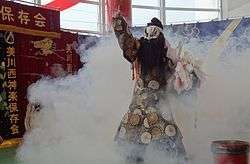須佐之男
Japanese
| Kanji in this term | |||
|---|---|---|---|
| 須 | 佐 | 之 | 男 |
| す Grade: S |
さ Grade: S |
の Jinmeiyō |
お Grade: 1 |
| goon | kun’yomi | ||

須佐之男 (Susanoo): a scene from a 神楽 (kagura) play where Susanoo slays Orochi, the eight-headed serpent.
Alternative forms
Etymology
Uncertain, with many possible derivations. One of the more compelling explanations is that this is a compound of すさ (susa, “roughness, wildness”, root word unattested in isolation, but found in terms such as 凄まじい (susamajii, “terrible, dreadful”) or 荒む (susamu, “to be wild, to be savage”)) + の (no, possessive particle) + 男 (o, “man”).[1] In this case, 須佐 (Susa) would be ateji (当て字).
Another theory is that this may be a compound of 須佐 (Susa, name of a place in Japan, where the god is supposed to have first touched earth) + の (no, possessive particle) + 男 (o, “man”).[2]
References
- p. 123日本文化の古層 (Nihon Bunka no Kosō, “The Substrata of Japanese Culture”, in Japanese) by A. Slavic, Mirai-sha, Tōkyō, 1984; →ISBN: http://books.google.com/books?id=crirHAAACAAJ
- 神道の本:八百万の神々がつどう秘教的祭祀の世界 (Shintō no Hon: Happyaku-man no Kamigami ga Tsudou Hikyōteki Saishi no Sekai, “The Shintō Book: The World of Esoteric Rituals, Crowded with 8 Million Gods”, in Japanese), Gakken, Tōkyō, 1992; →ISBN: http://books.google.com/books?id=mWxrmgEACAAJ
This article is issued from
Wiktionary.
The text is licensed under Creative
Commons - Attribution - Sharealike.
Additional terms may apply for the media files.